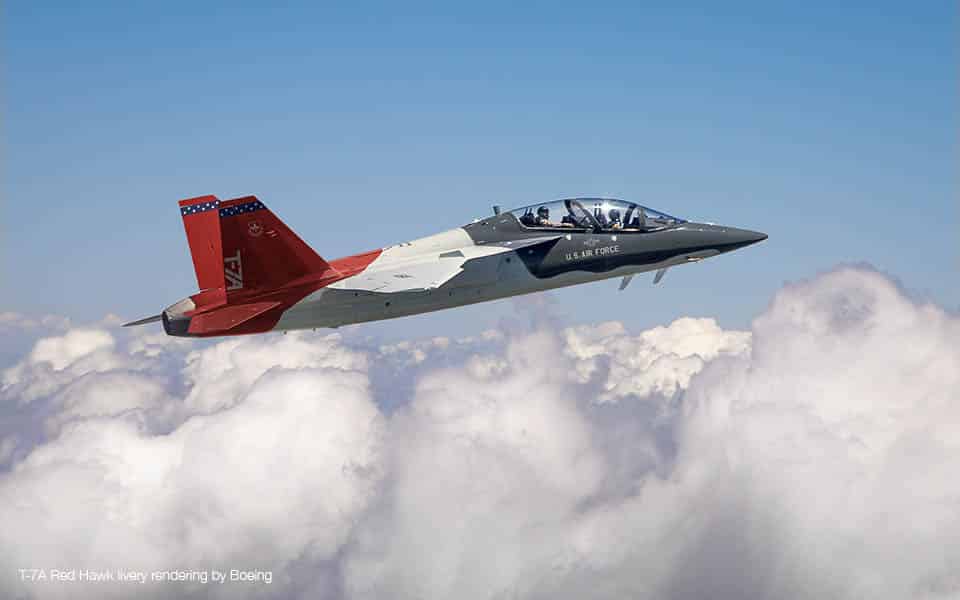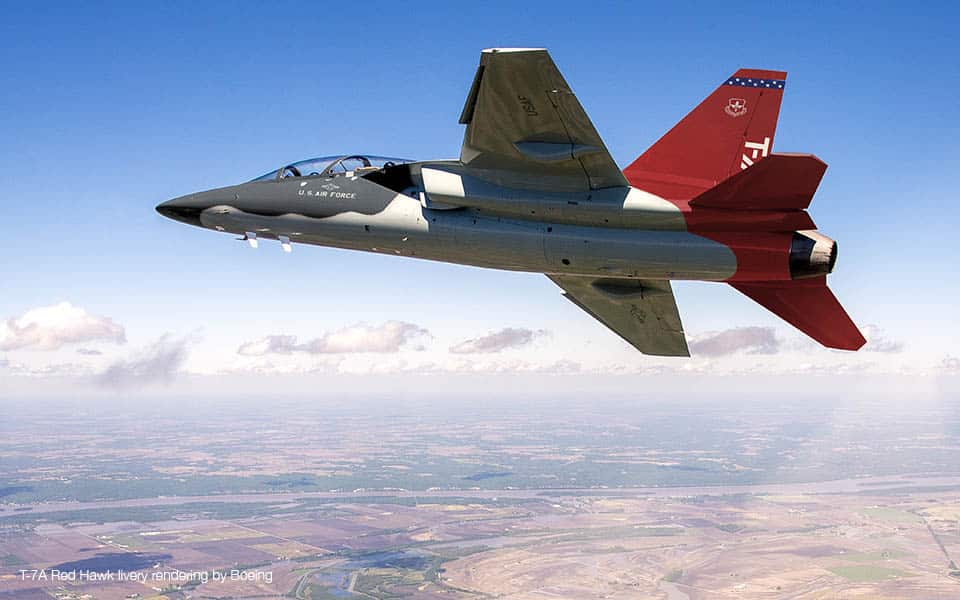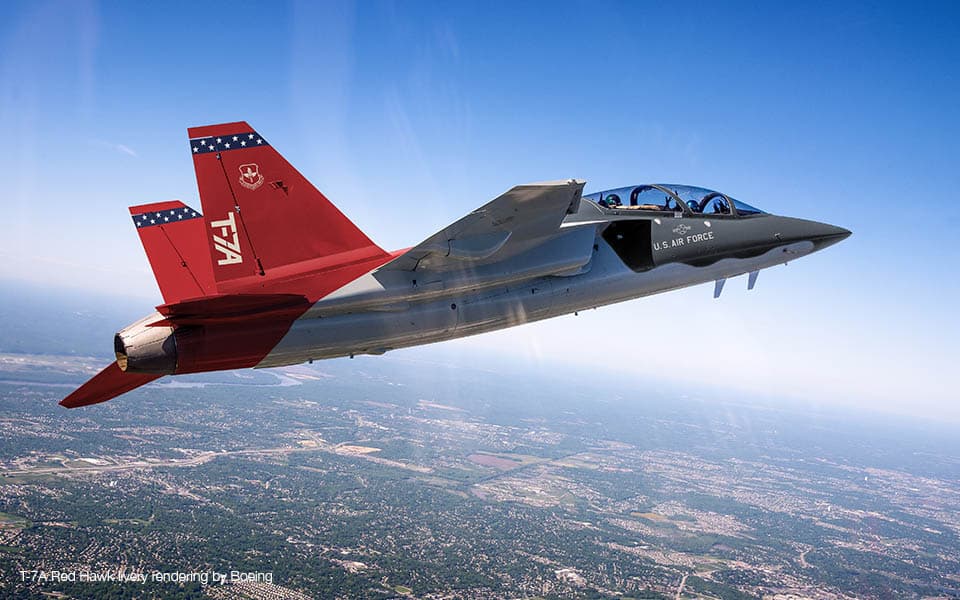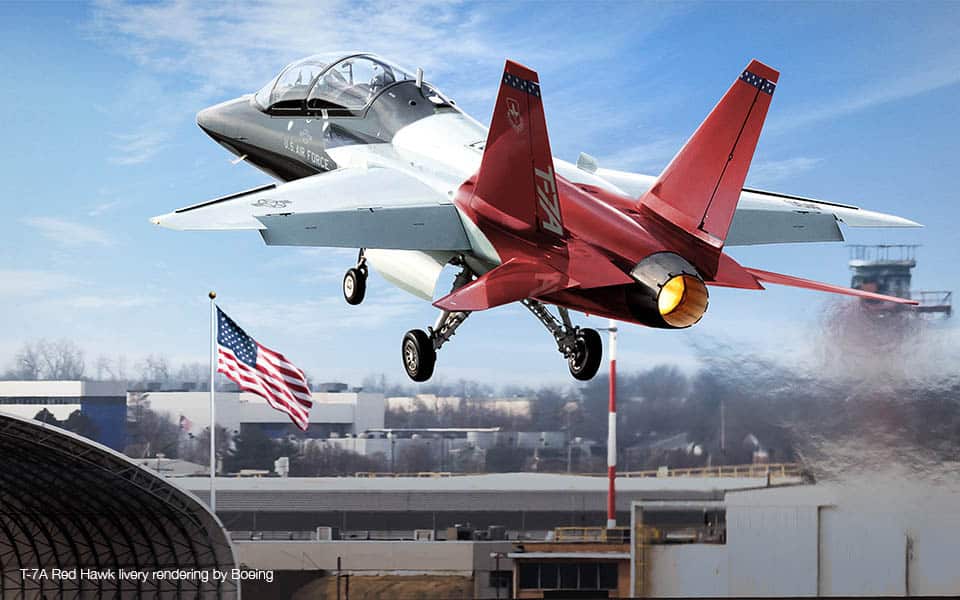Aerospace
Top 5 facts about Boeing’s T7 Red Hawk trainer aircraft

Boeing has unveiled the T7 Red Hawk, a highly anticipated aircraft created in conjunction with the Swedish business SAAB. Initially, Boeing won the proposal to replace the Northrop T38 Talon aircraft in the US Air Force’s new need. Boeing believes that with the Digital thread, aeroplanes may be maintained and designed in simple steps.

Boeing T-X Marketing Shots with 2 planes and 2 pilots at Sunrise Lambert Airport Ramp_MSF17-0004 Series_2/5/2017_RMS#306154
- The GE F404 engine powers it.
Boeing’s T-X is a single-engine advanced jet trainer with a twin tail, tandem seating, and retractable tricycle landing gear developed by Saab, a Swedish aerospace partner. A General Electric F404 afterburning turbofan engine powered the aircraft and display versions.
- For rapid development, use the digital engineering process.
To facilitate more rapid and economical future aircraft development, the aircraft was built using digital engineering procedures, agile software development, and an open architecture mission system. These cutting-edge, computer-assisted manufacturing processes support the US Air Force’s Digital Century Series plan while also expanding the supplier base.
Boeing Begins Build on New Zealand’s First P-8A Aircraft
- This plane was built in just three years.
As a result of defying the rules, this aircraft was created in under three years from idea to first flight. This demonstrates how technology can assist in obtaining quick results. This aircraft would be appropriate for maintainers, offering extremely immersive training and skill transfer, as well as advanced fighter-like performance qualities comparable to today’s 4th and 5th-generation fighters.
- It has the ability to upgrade to a fighter variant.
The T7 aircraft, according to Boeing, can be customised to the pilot’s preferences. Software can be simply adjusted to meet future needs. Rather of using the most expensive training methods, the T7 can meet the requirements of the Air Force and train students in less time.
First A380 powered by 100% Sustainable Aviation Fuel takes to the skies
The T-7A’s architecture allows for expansion should new tasks, such as an aggressive, light attack / fighter variant, become available. This aircraft is simple to maintain, and Saab has created new software for the T-7 to aid in development costs and speed. Splicing the aft segment with the wings takes only 30 minutes on the T-7A’s sophisticated and digital production line.
- A single plane can cost up to $19.3 million in the United States.
The Boeing design was officially announced as the US air force new advanced jet trainer to replace the T-38 Talon on September 27, 2018. At a cost of up to US$9.2 billion, a total of 351 aircraft, 46 simulators, maintenance training, and support will be provided. All 475 planes were purchased for $19.3 million each unit.
Boeing plans to sell approximately 2,700 Red Hawks around the world. The business is eyeing Serbia and Australia as prospective overseas customers in addition to the US Air Force.

Aerospace
When Ratan Tata was denied entry to the airfield at the Aero India show, he waited

During our visit to Aero India 2019, we had the unexpected opportunity to see Ratan Tata at the event, which was a thrilling moment for us. However, there was a surprising hiccup when the security staff didn’t allow him to enter due to a lack of a security pass.
Despite this, he remained calm and patiently waited for about 20 minutes until a member of the Tata team brought him the required pass, after which he calmly proceeded inside. It was a humbling sight, showcasing his composed demeanor even in such situations.
Ratan Tata ji is not only a renowned industrialist but also a trained pilot, holding a pilot’s license. In 2007, he became the first Indian civilian to fly the F-16 Falcon during the Aero India show in Bangalore—a proud moment for the nation.
His passion for aviation extended beyond flying, as he played a key role in shaping India’s aerospace industry. Under his leadership, Tata ventured into manufacturing and maintaining aerospace components while upholding its legacy of quality. Notably, Tata’s collaboration with Airbus to develop and manufacture the C295 aircraft is a testament to its growing influence in the sector.
-

 Aviation2 months ago
Aviation2 months agoMicrosoft Flight Simulator Raises $3 Million to Bring Back the An-225 Mriya
-

 Airlines2 months ago
Airlines2 months agoQantas Engineers Stage Walkout Over Cost of Living Concerns
-

 Airlines2 months ago
Airlines2 months agoQatar Citizens Can Travel to the United States Without a Visa
-

 Aviation2 months ago
Aviation2 months agoQatar Airways bans these new Electronic Devices on plane
-

 Airlines2 months ago
Airlines2 months agoJapan Airlines Rolls Out Free Domestic Flights to International Passengers
-

 Defence2 months ago
Defence2 months agoWhich Country Has the Largest Fleet of Fighter Aircraft?
-

 Airport2 months ago
Airport2 months agoWestern Sydney Airport Welcomes Its First Plane After 6 Years of construction
-

 Aviation2 months ago
Aviation2 months agoDid you know ? Once Boeing 747 carried 1088 passenger in 1991
















